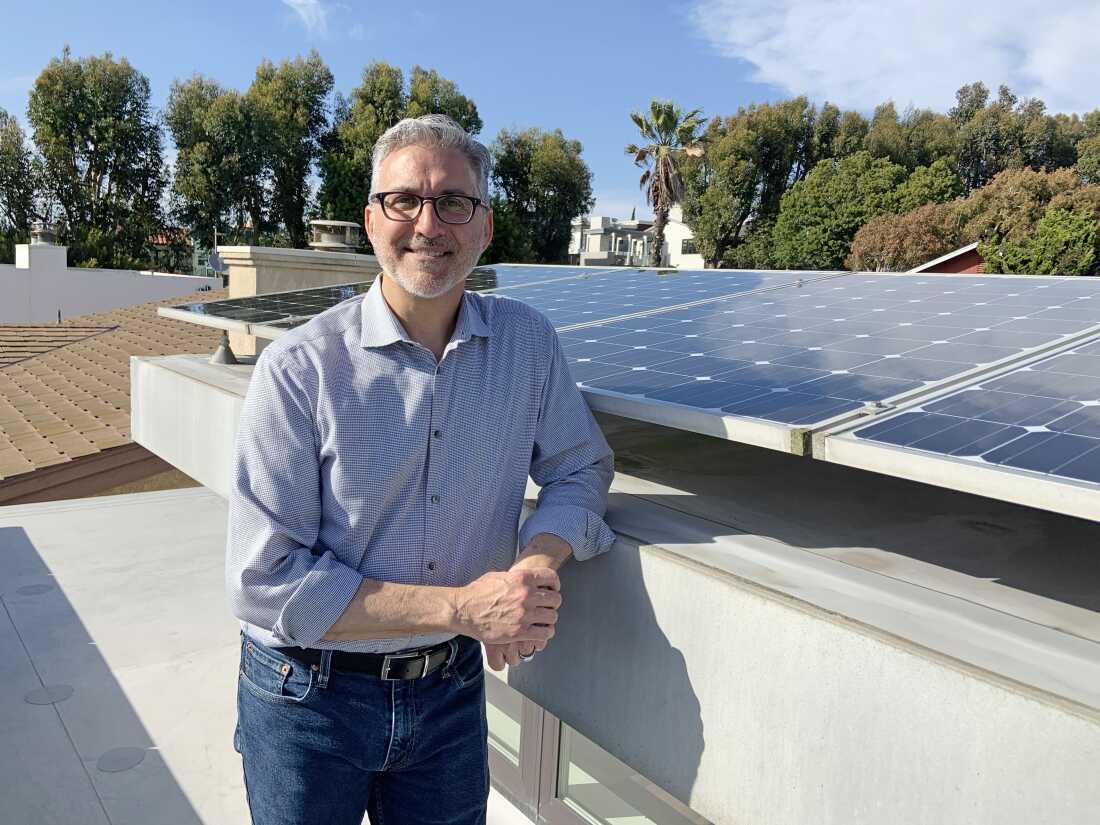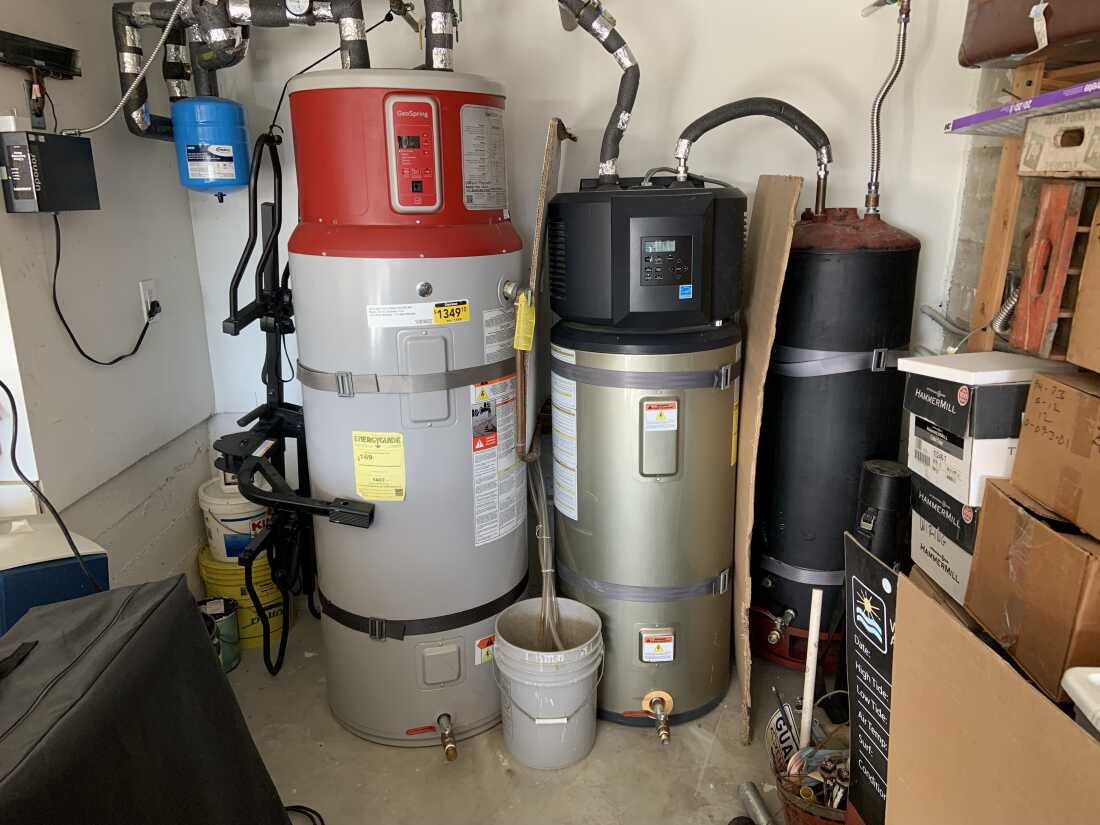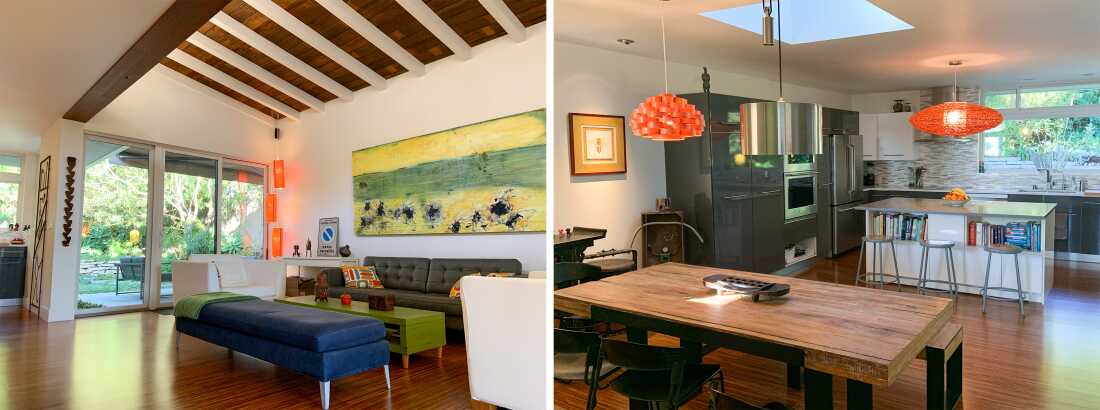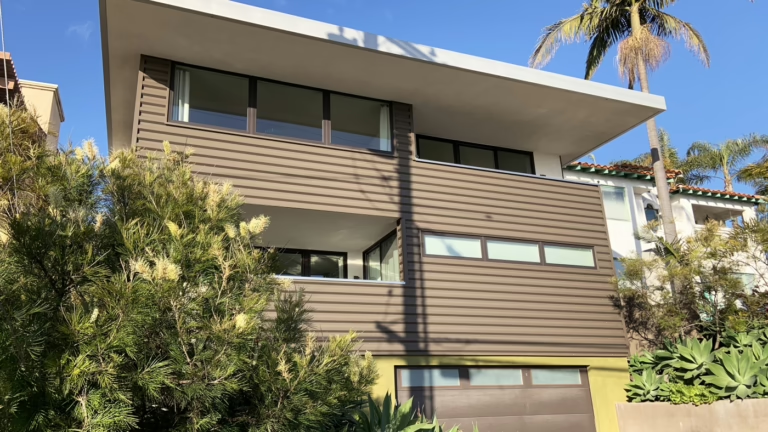The Fortunato’s Green Idea House in Hermosa Beach, Calif. features a flat roof with a five-foot overhang that blocks sunlight and cools the interior.
Jeff Brady/NPR
hide caption
toggle caption
Jeff Brady/NPR
HERMOSA BEACH, Calif. – As energy costs climb at a rate outpacing inflation, the idea of a home that generates more power than it consumes becomes increasingly attractive.
Robert Fortunato’s “Green Idea House” has been achieving this feat for over ten years. He transformed his family’s 1959 residence into a 2,150-square-foot eco-conscious home, managing to keep expenses below those of a conventional renovation.
“This was among the earliest net-zero energy, zero carbon demonstration homes built at a cost lower than typical construction,” Fortunato explains. The renovation utilized common building materials and readily available technologies, making it accessible to most homeowners.

Overseeing such an ambitious project demands significant dedication from the homeowner, involving extensive research, meticulous planning, and persistence when collaborating with contractors and suppliers. Additionally, ongoing adjustments are necessary to adapt to a climate that is warming more rapidly than anticipated.
Despite these challenges, the Fortunato family now enjoys a sleek, modern four-bedroom, two-bathroom home. While this type of project may not suit everyone, Fortunato hopes their journey inspires others to pursue similar sustainable renovations. Here are five key takeaways from the Green Idea House experience.

Robert Fortunato installed 26 solar panels on his roof, generating enough electricity for the home and two electric vehicles.
Jeff Brady/NPR
hide caption
toggle caption
Jeff Brady/NPR
Embrace energy production yourself
During the planning phase, Fortunato aimed to drastically reduce reliance on fossil fuels.
“We witnessed numerous occasions where oil companies neglected environmental responsibility,” he recalls. However, this transition wasn’t straightforward. “Our home originally had a gas water heater, gas furnace, and all gas-powered appliances,” he explains.
By disconnecting from the natural gas supply, Fortunato saved money during renovation by eliminating the need to reinstall gas lines. They replaced gas appliances with electric alternatives, including an induction cooktop.
To meet the home’s electricity needs and replace gas usage, Fortunato ventured into power generation by installing 26 solar panels on the roof. These panels produce enough energy to power the house and two electric vehicles.
“We haven’t received an electric or gas bill in over 13 years,” Fortunato states. The initial investment for the solar array was $18,000, but with annual utility savings around $4,800, the system paid for itself within four years. Since the home remains grid-connected, there are still minor connection fees.
While rooftop solar isn’t financially feasible for everyone, and the industry sometimes faces criticism for aggressive sales tactics, there are resources available to help consumers make informed decisions.

The Green Idea House features two heat pump water heaters-one for domestic hot water and another for heating radiators.
Jeff Brady/NPR
hide caption
toggle caption
Jeff Brady/NPR
Extensive research and thoughtful design are essential
From the street, Fortunato’s three-story contemporary home blends seamlessly with the upscale modern and Mission-style houses nearby.
A notable design element is the flat roof with a five-foot extension over the front facade. This overhang conceals the solar panels, which some find visually unappealing, keeping them out of sight from the street. Beyond aesthetics, the overhang plays a crucial role in energy conservation.
“About 60% of the heating and cooling energy savings come from that overhang alone,” Fortunato notes. During summer, it shades the southwest-facing windows when the sun is high, reducing heat gain. In winter, the lower sun angle allows sunlight to enter through the windows, naturally warming the interior.
This approach draws inspiration from ancient architectural wisdom, such as the cliff dwellings of Native Americans in what is now Mesa Verde National Park, Colorado.
On the East Coast, the Harvard Center for Green Buildings and Cities (CGBC) applies similar principles in its HouseZero facility in Cambridge, Massachusetts, adapting the concept with vertical fins to shade windows from low-angle sun in the east and west.
“Instead of horizontal overhangs, vertical shading devices control sunlight on the east and west sides where the sun is lower,” explains Ali Malkawi, professor of architectural technology and CGBC director.
HouseZero serves as both a research lab and CGBC’s headquarters, equipped with miles of wiring and hundreds of sensors. Yet, Malkawi emphasizes that high-tech solutions must be integrated with sound architectural design.
“Technology alone can’t compensate for poor design. We must apply time-tested principles that have been understood for centuries,” he says.
In the Green Idea House, an open staircase functions as a “thermal chimney,” promoting natural ventilation to cool the home without air conditioning. “By opening two vented windows at the top, hot air escapes naturally,” Fortunato explains.
Hermosa Beach’s temperate climate supports the effectiveness of these passive cooling strategies. Fortunato acknowledges that homes in regions with more extreme weather would require additional measures to maintain comfort.
To minimize daytime electricity use, the design incorporates multiple skylights that flood the interior with natural light. After sunset, energy-efficient LED bulbs reduce power consumption.

Fortunato aimed for a home that balances energy efficiency with appealing design, avoiding extremes like futuristic or overly rustic styles.
Jeff Brady/NPR
hide caption
toggle caption
Jeff Brady/NPR
Maintain unwavering commitment to your objectives
While switching to LED lighting is now commonplace, many other sustainable features lack widespread adoption or industry support. Fortunato found it necessary to consistently remind contractors and suppliers of his environmental goals to ensure they were met.
For instance, the brown metal siding was chosen because it was manufactured locally in Fontana, California, reducing transportation emissions. However, the supplier initially planned to ship siding from Texas due to color availability. Fortunato negotiated to select a similar shade produced nearby.

Additionally, Fortunato upgraded an old garage door opener that consumed 15 watts continuously to a new model that uses approximately 80% less energy by activating only when needed. Though a minor improvement, it reflects his attention to detail.
Chris Magwood, a consultant with the clean energy nonprofit Rocky Mountain Institute (RMI), stresses the importance of clearly defining goals and questioning every decision to ensure they are fulfilled.
“My role is like that of a persistent child asking ‘why?’-challenging assumptions to clarify the purpose behind choices,” says Magwood, author of a book on designing energy-efficient homes.
He notes that rooftop solar panels make the most environmental sense in regions heavily reliant on coal-fired electricity, such as West Virginia, but may be less impactful in states like California where cleaner energy predominates.
Magwood acknowledges that building an efficient home requires dedication but is becoming more accessible thanks to certification programs like Energy Star and LEED, which hold contractors and manufacturers accountable to energy standards.
Be prepared to revise your strategy
When Fortunato began his renovation 15 years ago, many now-common technologies were just emerging. This included heat pump water heaters, which conserve energy by transferring heat rather than generating it directly.
He installed two such units in his sunlit garage-one for domestic hot water and another to heat radiators throughout the house. However, contractors initially treated the idea skeptically, quoting installation costs far above market rates to cover their learning curve.
“I had to educate them on how these systems work,” Fortunato recalls.
Designed without air conditioning to conserve energy, the home was planned assuming a moderate temperature increase of about four degrees Fahrenheit over its lifespan.
“We’ve already surpassed that estimate,” he admits, referencing faster-than-expected climate warming. To adapt, he added shades to skylights to reduce heat gain and is considering installing a small air conditioning unit if necessary.
Fortunato also contends with the irony of pollution from nearby traffic depositing soot on his solar panels, diminishing their efficiency and requiring regular cleaning.
Don’t expect widespread adoption overnight
The Fortunato family hoped their project would inspire others to build similar energy-positive homes.
“We aimed to create a home that anyone would find desirable to live in,” Fortunato says, striving for a balance between affordability and aesthetic appeal after seeing some energy-efficient homes that resembled “spaceships” or “primitive huts.”
They have shared their knowledge widely, hosting numerous tours and even participating in a reality TV show to promote sustainable living.
Yet, homes that generate more energy than they consume remain an extremely small fraction of the nation’s 140 million housing units-a fact Fortunato finds discouraging.
Ultimately, he hopes the financial savings his family enjoys-approximately $400 per month combining home energy and vehicle fuel costs-will motivate others to follow suit, with benefits compounding over time.






















